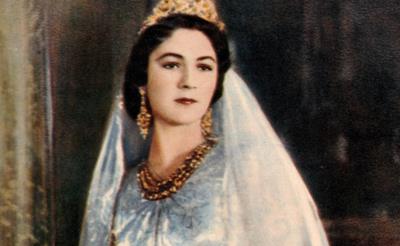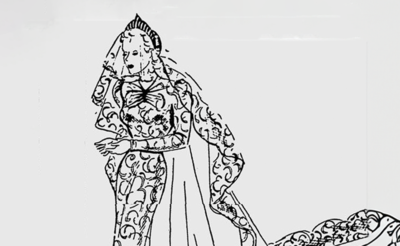Styled Archives: Queen Farida’s Timeless Silver Wedding Dress
Queen Farida dropped traditional embroidery and heavy beading for classy lace, shimmering silver and a trailing train.

Queen Farida, born Safinaz Zulficar in September 1921 in Alexandria, Egypt, served as Queen of Egypt for nearly eleven years as the first wife of King Farouk. She was the first queen since Cleopatra to emerge from the traditional seclusion of Egyptian royalty, assuming a public role that included attending state functions and acting as the honorary protector of various charities, embodying the modern image the monarchy sought to project at the time. Dearly beloved by the Egyptian people, she inspired public protests in her favour when her marriage to King Farouk ended in divorce in 1948.

Zulficar adopted the name Farida to align with King Farouk’s preference for names beginning with the letter ‘F.’ Married at the age of 16, Queen Farida quickly became a symbol of elegance and modernity in Egypt. Her wedding trousseau was meticulously crafted by the finest tailors in Cairo and Alexandria, while King Farouk personally selected The House of Worth to design her wedding gown.
Founded in 1858 by English designer Charles Frederick Worth, The House of Worth was a Paris-based fashion house synonymous with haute couture. Worth, often called the “father of haute couture,” revolutionised fashion with innovations such as the use of mannequins to display designs and popularising the hourglass silhouette—fitted bodices, cinched waists, and full skirts.

For over a century, Maison Worth remained the premier couturier for European royalty, including Queen Victoria, Empress Eugénie of France, Empress Elisabeth of Austria, and Queen Alexandra of the United Kingdom, as well as celebrated actresses and singers like Sarah Bernhardt, Lillie Langtry, and Nellie Melba. Though the original House of Worth ceased operations in the mid-20th century, its legacy endures in its timeless designs, which remain highly coveted by collectors and fashion connoisseurs.

Under the direction of French designers and Charles Worth’s descendants, Jacques and Roger Worth, the House of Worth created a silver lace gown for Queen Farida. The dress, featuring long sleeves, a fitted bodice, and a mermaid-cut skirt, flowed into an eight-yard train of silver satin lamé. The gown’s simple elegance—eschewing heavy embroidery in favour of a sleek, modern silhouette—was complemented by a tulle veil edged in the same silver lace, extending half a yard beyond the train. By 1930s standards, this understated glamour marked a departure from the more ornate royal gowns of the past. The gown was estimated to have cost between $3,000 and $4,000.
Queen Farida also wore a spectacular Boucheron necklace, a part of her ‘shabka’ (bridal gift) from King Farouk. Comprising 114 diamonds weighing a total of 346 carats, the necklace had been crafted for the 1937 International Exposition of Art and Technology at an estimated cost of 27,000 Egyptian pounds. She was further adorned with a dazzling diamond tiara by court jeweller Adolphe Kramer, its lotus-flower motifs a gift from Queen Nazli, King Farouk’s mother.

The wedding photographs, taken by Egyptian-Armenian photographer Aram Alban at Villa Shammas, captivated the public and set a new standard. Queen Farida became the first Egyptian queen to be photographed on her wedding day, an unprecedented step into the modern world. King Farouk had rented Villa Shammas for Queen Farida and her family to be closer to the wedding preparations, offering a convenient alternative to their more remote family home in Janaklis, Alexandria.
- Previous Article Qatari-Egyptian Label Mioj Draws Inspiration From the Aspen Mountains
- Next Article Monochrome Monday: The Metallic Silver Edition

















